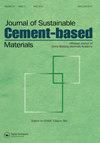Microbially/CO2-derived CaCO3 cement and its microstructural and mechanical performance
IF 4.2
3区 工程技术
Q1 CONSTRUCTION & BUILDING TECHNOLOGY
Journal of Sustainable Cement-Based Materials
Pub Date : 2023-02-20
DOI:10.1080/21650373.2023.2178539
引用次数: 11
Abstract
Compared with the production of ordinary Portland cement (OPC) with large carbon emissions, biological carbon sequestration to prepare low-carbon cement can effectively decrease carbon dioxide (CO2) emissions, which can reduce the greenhouse effect, thereby reducing the frequency and intensity of climate disasters. Carbon-capturing bacteria (CCB) can capture atmospheric CO2 and convert it into bicarbonate ions, which can be combined with calcium ions to form CaCO3 cement that can partially replace OPC for dust control. This study compared the ability of two CCBs (Paenibacillus mucilaginosus and Streptomyces microflavus ) to capture CO2. The biomineralization efficiency of CaCO3 for P. mucilaginosus (39.34%) was much higher than that for S. microflavus (7.38%) in a Ca(NO3)2 solution in the concrete-curing room environment. The decomposition temperature of the CaCO3 crystals in DI was slightly higher than that of P. mucilaginosus and significantly higher than that of S. microflavus. When the spraying time was equal to three, 10% carbide sludge (CS) content was optimal according to the surface hardness (HD) of the consolidation layer of the sand samples. The CaCO3 mineralized by CCBs can be used to consolidate desert sand and dust in practical engineering applications.微生物/CO2衍生CaCO3水泥及其微观结构和力学性能
与生产碳排放量大的普通硅酸盐水泥(OPC)相比,生物固碳制备低碳水泥可以有效减少二氧化碳(CO2)的排放,从而减少温室效应,从而降低气候灾害的频率和强度。碳捕获细菌(CCB)可以捕获大气中的二氧化碳并将其转化为碳酸氢盐离子,碳酸氢盐离子可以与钙离子结合形成CaCO3水泥,可以部分取代OPC进行粉尘控制。本研究比较了两种CCBs(粘乳类芽孢杆菌和微黄链霉菌)捕获CO2的能力。在混凝土养护室内的Ca(NO3)2溶液中,黏液棘菌的CaCO3生物矿化效率(39.34%)远高于微黄菌(7.38%)。CaCO3晶体在DI中的分解温度略高于p.a mucilaginosus,显著高于s.a microflavus。当喷施时间为3次时,根据砂样固结层表面硬度(HD),碳化物污泥(CS)含量为10%为最佳。在实际工程应用中,CCBs矿化CaCO3可用于固结沙漠沙尘。
本文章由计算机程序翻译,如有差异,请以英文原文为准。
求助全文
约1分钟内获得全文
求助全文
来源期刊
CiteScore
6.60
自引率
15.90%
发文量
71
期刊介绍:
The Journal of Sustainable Cement-Based Materials aims to publish theoretical and applied researches on materials, products and structures that incorporate cement. The journal is a forum for discussion of research on manufacture, hydration and performance of cement-based materials; novel experimental techniques; the latest analytical and modelling methods; the examination and the diagnosis of real cement and concrete structures; and the potential for improved cement-based materials. The journal welcomes original research papers, major reviews, rapid communications and selected conference papers. The Journal of Sustainable Cement-Based Materials covers a wide range of topics within its subject category, including but are not limited to: • raw materials and manufacture of cement • mixing, rheology and hydration • admixtures • structural characteristics and performance of cement-based materials • characterisation techniques and modeling • use of fibre in cement based-materials • degradation and repair of cement-based materials • novel testing techniques and applications • waste management

 求助内容:
求助内容: 应助结果提醒方式:
应助结果提醒方式:


